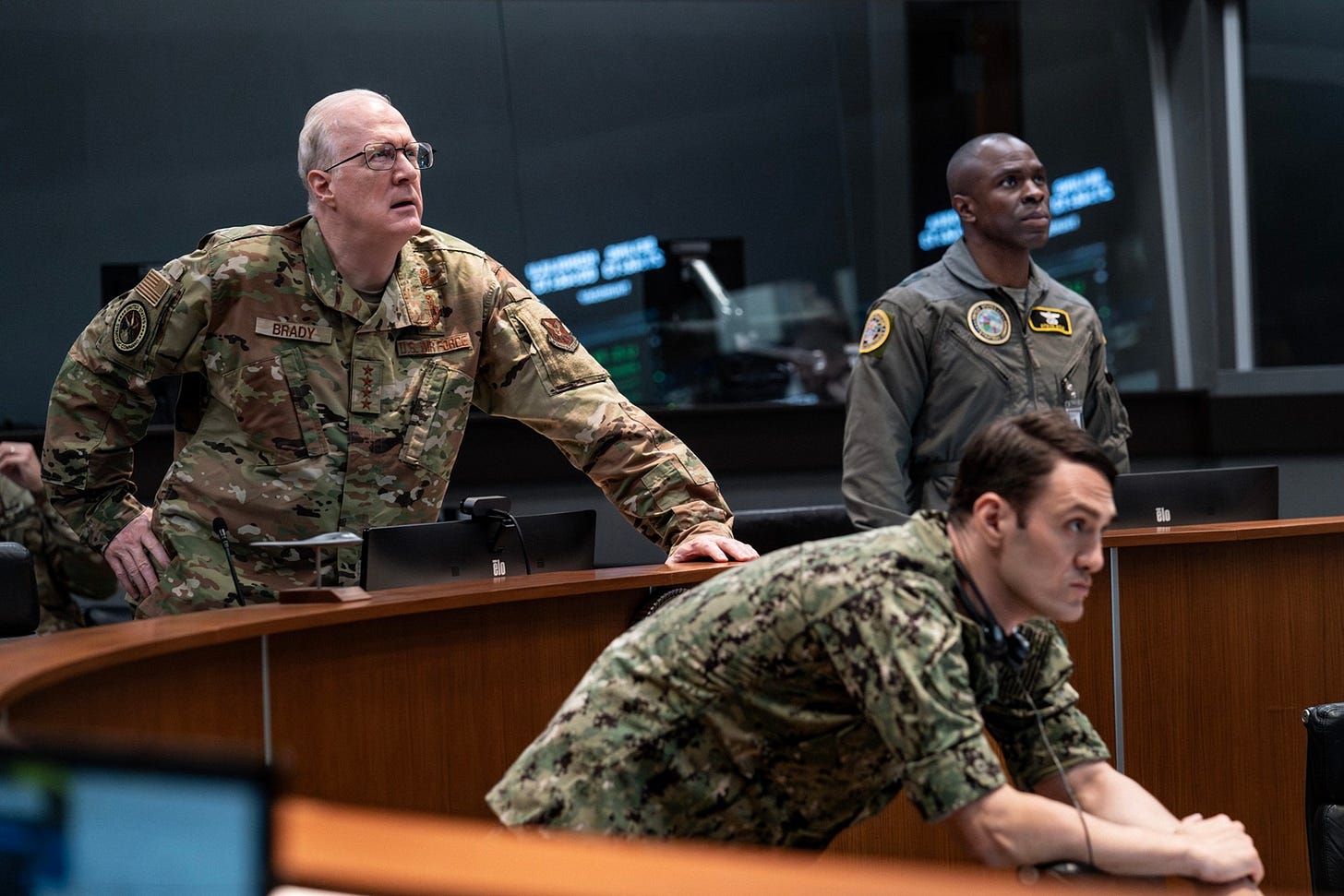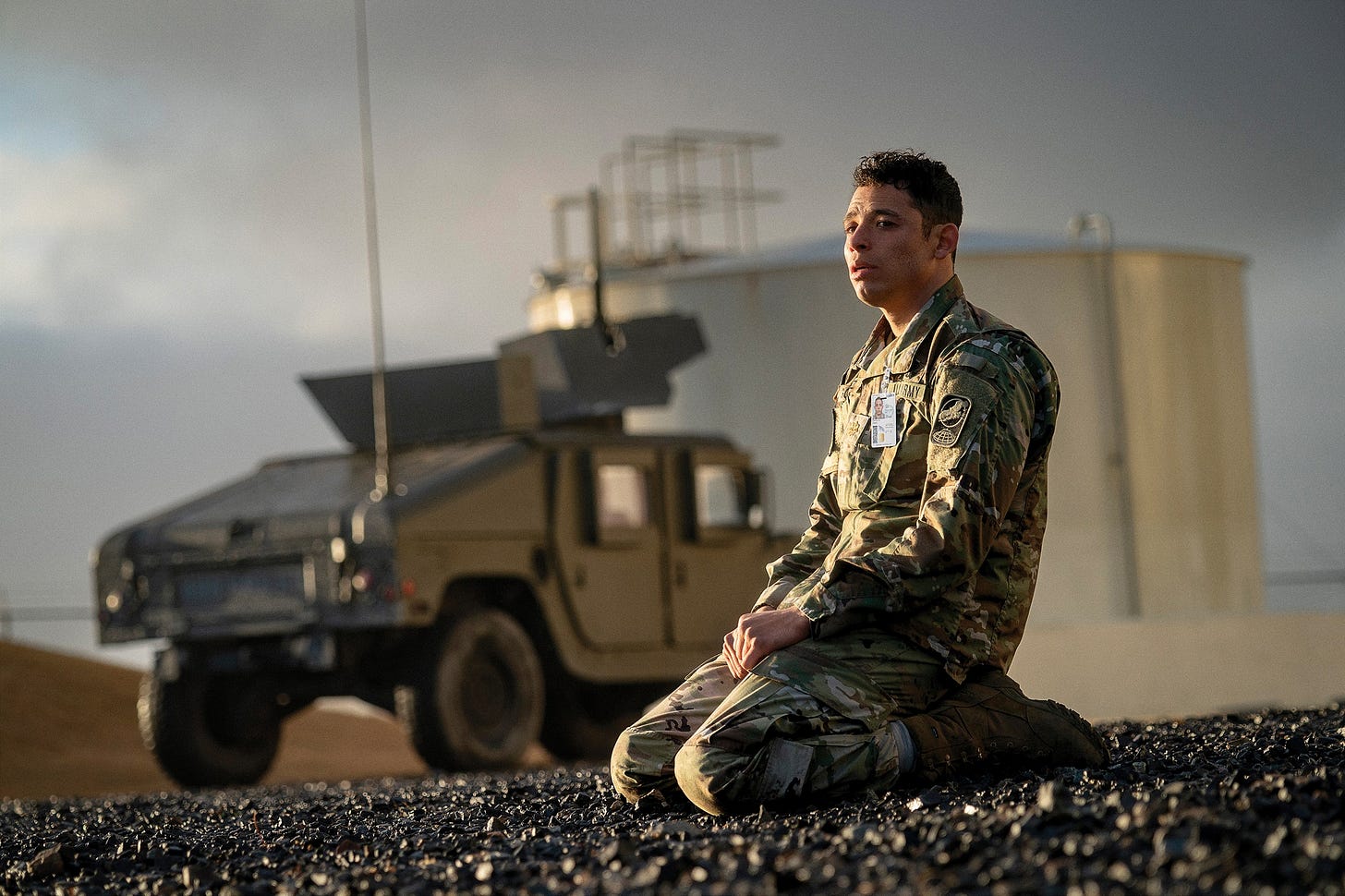Kathryn Bigelow Builds 'A House of Dynamite'
How a single, unsettling question led to the year's most authentic and necessary cinematic crisis
The question is as simple as it is catastrophic: what happens when the world has 18 minutes until potential annihilation? This is the terrifying, real-time premise of director Kathryn Bigelow’s new thriller, A House of Dynamite.
On September 27th in New York, a press conference with the film’s key creative team revealed the project was born from a question the acclaimed director had about the world’s precarious nuclear situation. What she and writer Noah Oppenheim uncovered in their research was a paradox so unsettling it formed the core of the film: the unimaginable power to end civilization rests almost entirely with one person, who may be the least prepared to wield it.
“The most surprising was how the president has so authority on something so epic and so potentially catastrophic,” Bigelow explained. “It’s just this one man and, within a matter of minutes, has to decide about... the utilization of these weapons or not”. The conversation offered a blueprint for how a team of artists—in front of and behind the camera—constructed a cinematic pressure cooker, designed not just to thrill, but to confront an audience with a reality many have chosen to forget.
The Paradox at the Heart of Power
One of the great surprises for Bigelow was “being able to work with Noah Oppenheim,” whose “acumen on the subject is kind of, like, none other”. Their collaboration began with deep research, and one conversation in particular rattled them both. They asked a former senior Pentagon and CIA official how much a president practices for this ultimate decision. The response was, “Not at all”.
“When the president takes office... they’re given a very short briefing on the ‘football’... less than an hour sometimes. And that’s it,” Oppenheim shared. “And then they don’t think about it ever again”. This stood in stark contrast to what they learned at US Strategic Command (StratComm), where an admiral told them “they practice the protocol for nuclear weapons 400 times a year”. This stunning gap between the preparedness of the operators and the ultimate decision-maker became the film’s central tension. It led Bigelow to what she calls an “interesting paradox”: the idea of launching a “defensive measure that... could be global annihilation”. She asked, “Yet, what are you defending? There’s nothing left”.
An Architecture of Anxiety
To immerse the audience in this high-stakes confusion, the filmmakers made a crucial structural choice early on. Instead of a traditional linear narrative, the film is broken into three distinct chapters, each replaying the same 18-minute window from a new perspective. This was done to “stay in real time” and conduct a “deep dive in each one of the halls of power as you climb up the, sort of, food chain”.
According to Oppenheim, the structure is designed to replicate the chaos of a real event. “In the first watching, the audience is absorbing it in that way,” he said. “And then, we pause, and they have an opportunity now to re-experience it with new context”. It’s a luxury that highlights the terrifying reality of the situation. “Unfortunately, in real life, the folks who have to make these decisions don’t get the luxury of a second or third run-through”.

The Unrelenting Pursuit of Realism
“The authenticity is paramount in something like this,” Bigelow stated, emphasizing the responsibility of taking an audience into closed-off spaces. To achieve this, the production embedded high-level advisors into the fabric of the film. Bigelow herself insisted, “we didn’t shoot anything that they didn’t say, okay, that is relatively accurate”.
Rebecca Ferguson, who plays Olivia, had a direct line to Larry Pfeiffer, the former real-life Head of the Situation Room. “I had his WhatsApp, his messages. I had email,” she said, explaining her drive to ensure every detail was correct, “down to, who would get this email first?”. For actor Tracy Letts, the advisors were even closer; some were extras in his scenes. “They’re guys who have actually sat in my seat,” he explained. This allowed him to understand the attitude of his character. The advisors told him, “You answer to the President, and beyond that, you don’t have to worry about anybody around you”. Letts found this note incredibly helpful. “Well, that’s very freeing to hear”.
Mastering the highly specific jargon proved a significant hurdle. Oppenheim noted that Bigelow “interrogated” every line, constantly asking, “Is this how it would really happen? Is this how they would really say it?”. Letts called the dialogue “a foreign language,” citing “militarized words” like “Operationalize” that are not part of everyday speech.
Anthony Ramos, whose character is stationed at a monitoring base, was struck by the advisors who live that life of constant vigilance. “While we’re out here eating our little croissant and drinking our little latte,” he said, “they’re, like, in front of their shit like this”. The ultimate validation came when those same advisors watched the performance and told the actors, “dang, like you guys took us there... That’s how it feels for us”.

Capturing Controlled Chaos
Achieving this level of realism required a specific, documentary-like approach to filmmaking. Jason Clarke, another member of the ensemble, effused about the process: “I love the way Barry and Kathryn shoot... It’s my favorite way to shoot. It’s so easy. It’s so simple, and yet it’s so immediate”.
This method involves cinematographer Barry Ackroyd lighting the entire environment, not just a specific spot, and then covering the action with multiple cameras. “There’s no marks,” Bigelow explained. “Basically, the actor is left alone to do their job... and then, he captures it”. Tracy Letts described it as a “tough gig,” at one point counting 25 cameras rolling on him simultaneously. He praised Bigelow as “the calm at the center of the storm,” an interrogator who guides through questions rather than commands. “I always felt I could turn to Kathryn with a question or even to just, kind of, stop the proceedings and say, wait a minute, I don’t understand what we’re doing here”.
This intense environment forged a unique focus, but Rebecca Ferguson revealed there was still room for levity. Surrounded by actors ad-libbing complex technical dialogue, she invented her own lines. “I made pizza toppings,” she confessed, to laughter. “I was literally going, ‘So did you want salami on that one, yeah?’”. It was a way to stay present in the scene’s intensity while acknowledging the human need for a release. “It’s authentic,” she said, “but we also had fun. Like, which is also important. There’s also joy in the room”.
The Post-Production of Tension
The film’s unbearable tension was further sculpted in post-production. Editor Kirk Baxter called the script a “gift for a film editor,” an opportunity to “look clever”. He praised Barry Ackroyd’s on-the-fly camera work, noting the cinematographer almost deserved a “co-editor credit” because “part of the pacing is based on his sort of live decision-making”. Baxter approached the complex narrative by first cutting the entire film for “story and emotional performance,” and then doing a complete second pass purely “concentrating on accuracy”. This ensured every event aligned perfectly, a task Bigelow likened to “three-dimensional chess”. For Baxter, the human element was key; he singled out Jason Clarke’s performance, calling him “the scene-stealer” for the powerful “silent work” and micro-expressions he delivered.
The score, by composer Volker Bertelmann, was designed to add an emotional layer without overpowering the drama. “When I see a film the first time, I try to... stick to the emotion that I have,” he said. He felt compelled to musically translate the idea that “human life is so worthy. Every life”. For the film’s most urgent moments, he had woodwind players “moan into their instruments,” creating an “animalistic kind of sound where they nearly cry”. This subtle, haunting effect injects pure human dread into the sterile environment of the situation room.
An Invitation
The purpose of A House of Dynamite, however, lies outside the theater. For Bigelow, the film was never just a thriller, but a catalyst. It is, she said, “an invitation to the audience to take away something.” She hopes to ignite a renewed and urgent “conversation about nuclear weapons,” a subject she feels has been dangerously ignored. After experiencing the film’s relentless tension, it’s a conversation that feels impossible to ignore. “It’s really an opportunity,” she concluded, “a reach out to the audience to then hopefully take the conversation further.”
A House of Dynamite premieres in select theaters on October 10th and on Netflix on October 24th. This article is based on the transcript provided to attending journalists following the press conference.






A topic I’ve tried to keep far away from my already full mind. I am intrigued and look forward to seeing it.